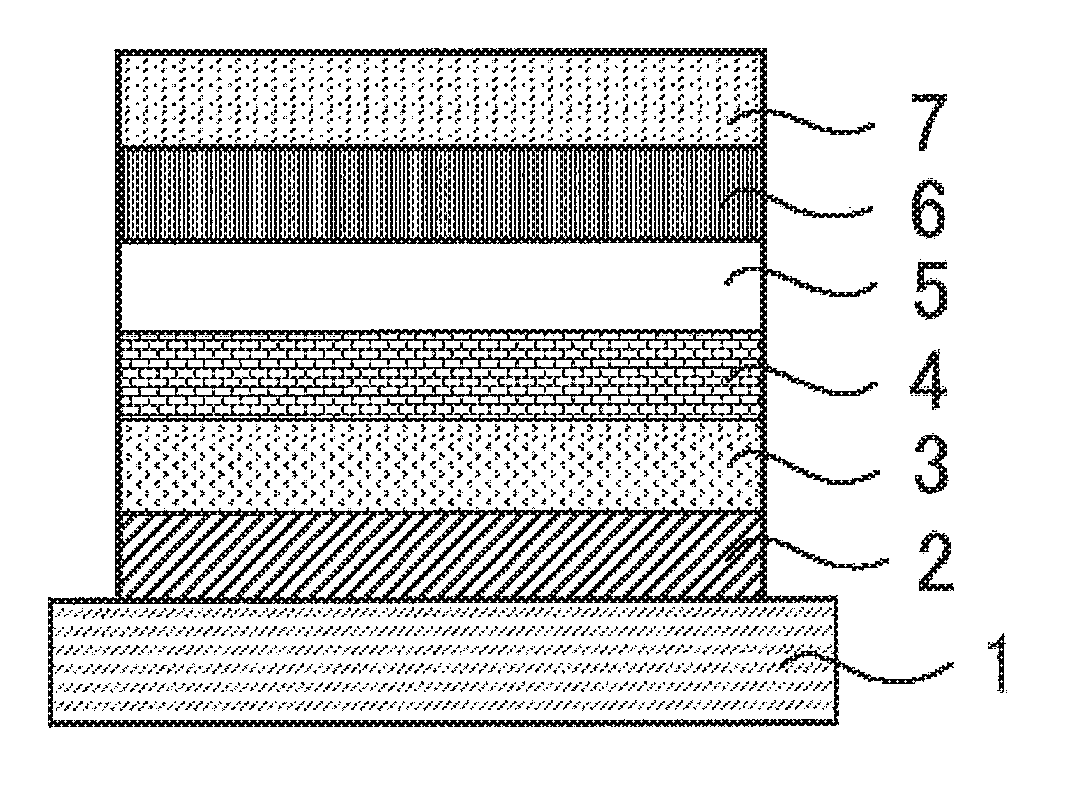Compound, light emitting material, and organic light emitting device
a light-emitting device and light-emitting material technology, applied in the field of compounds, light-emitting materials, and organic light-emitting devices, to achieve the effect of high light-emission efficiency
- Summary
- Abstract
- Description
- Claims
- Application Information
AI Technical Summary
Benefits of technology
Problems solved by technology
Method used
Image
Examples
synthesis example 1
Synthesis of Compound 1
[0119]4-Bromoacetophenone (11.2 g, 56.3 mmol), benzaldehyde (2.87 mL, 28.1 mmol), and ammonium acetate (27.8 g, 0.366 mmol) were mixed in acetic acid (60 mL), and refluxed for 5 hours. After cooling to room temperature, a solid content obtained by filtration was rinsed with acetic acid, and after drying, recrystallized from ethyl acetate, thereby providing 2,6-bis(4-bromophenyl)-4-phenylpyridine as a colorless solid matter (2.9 g, yield: 22%).
[0120]1H NMR (CDCl3, 400 MHz): δ 7.47-7.57 (m, 3H), 7.62-7.66 (m, 4H), 7.71-7.75 (m, 2H), 7.87 (s, 2H), 8.04-8.09 (m, 4H)
[0121]13C NMR (CDCl3, 100 MHz): δ 117.15, 123.65, 127.16, 128.65, 129.19, 131.88, 136.40, 138.21, 138.66, 150.63, 156.44
[0122]2,6-Bis(4-bromophenyl)-4-phenylpyridine (1.03 g, 2.24 mmol), 10H-phenoxazine (1.02 g, 5.57 mmol), and potassium carbonate (1.57 g, 11.2 mmol) were mixed in toluene (50 mL), and after bubbling with nitrogen for 15 minutes, palladium acetate (15 mg, 0.07 mmol) and tri-tert-butyl ph...
synthesis example 2
Synthesis of Compound 2
[0127]2,6-Bis(4-bromophenyl)-4-phenylpyridine (2.87 g, 6.21 mmol), 10H-phenothiazine (3.03 g, 15.5 mmol), and potassium carbonate (4.35 g, 31.1 mmol) were mixed in toluene (70 mL), and after bubbling with nitrogen for 15 minutes, palladium acetate (84 mg, 0.37 mmol) and tri-tert-butyl phosphate (10% by weight toluene solution, 3.60 mL, 1.49 mmol) were added thereto, followed by refluxing for 48 hours. The product was cooled to room temperature, filtered with silica gel, and rinsed with ethyl acetate / methylene chloride / toluene (1 / 5 / 5). The filtrate was concentrated to provide a solid matter, which was purified by silica gel column chromatography with ethyl acetate / toluene / petrol (2.5 / 20 / 77.5), and then methylene chloride / petrol (30 / 70), thereby providing the compound 2 as a pale yellow solid matter (4.13 g, yield: 95%). The compound was further purified by recrystallization from toluene and sublimation purification (315° C., 10−6 mBar).
[0128]m.p.: 254-260° C. (...
synthesis example 3
Synthesis of Compound 5
[0132]2,6-Bis(4-bromophenyl)-4-phenylpyridine (1.0 g, 2.16 mmol), 9,9-dimethyl-9,10-dihydroacridine (1.04 g, 4.98 mmol), and sodium tert-butoxide (520 mg, 5.4 mmol) were mixed in toluene (40 mL), and after bubbling with nitrogen for 15 minutes, tris(dibenzylideneacetone) dipalladium(0) (20 mg, 0.022 mmol) and 1,1′-bis(diphenylphosphino) ferrocene (24 mg, 0.044 mmol) were added thereto, followed by refluxing for 72 hours. The product was cooled to room temperature, filtered with silica gel, and rinsed with ethyl acetate / methylene chloride / toluene (1 / 5 / 5). The filtrate was concentrated to provide a solid matter, which was purified by silica gel column chromatography with toluene / petrol / methylene chloride (25 / 75 / 0), then (30 / 60 / 10), and then (30 / 50 / 20), thereby providing the compound 5 as a colorless solid matter (1.45 g, yield: 93%). The compound was further purified by recrystallization from toluene / petrol and sublimation purification (320° C., 10−6 mBar).
[0133...
PUM
| Property | Measurement | Unit |
|---|---|---|
| structure | aaaaa | aaaaa |
| organic | aaaaa | aaaaa |
Abstract
Description
Claims
Application Information
 Login to View More
Login to View More - R&D
- Intellectual Property
- Life Sciences
- Materials
- Tech Scout
- Unparalleled Data Quality
- Higher Quality Content
- 60% Fewer Hallucinations
Browse by: Latest US Patents, China's latest patents, Technical Efficacy Thesaurus, Application Domain, Technology Topic, Popular Technical Reports.
© 2025 PatSnap. All rights reserved.Legal|Privacy policy|Modern Slavery Act Transparency Statement|Sitemap|About US| Contact US: help@patsnap.com



